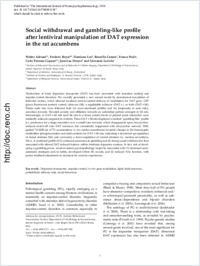Social withdrawal and gambling-like profile after lentiviral manipulation of DAT expression in the rat accumbens
- Adriani, Walter Sections of Behavioral Neuroscience and of Molecular & Cellular Imaging, Department Cell Biology & Neurosciences, Istituto Superiore di Sanità, Roma, Italy
- Boyer, Frederic Department of Medicine, University of Fribourg, Switzerland
- Leo, Damiana Institute of Genetics and Biophysics, CNR, Naples, Italy
- Canese, Rossella Sections of Behavioral Neuroscience and of Molecular & Cellular Imaging, Department Cell Biology & Neurosciences, Istituto Superiore di Sanità, Roma, Italy
- Podo, Franca Sections of Behavioral Neuroscience and of Molecular & Cellular Imaging, Department Cell Biology & Neurosciences, Istituto Superiore di Sanità, Roma, Italy
- Perrone-Capano, Carla Institute of Genetics and Biophysics, CNR, Naples, Italy - Department of Biological Sciences, University of Naples, Italy
- Dreyer, Jean-Luc Department of Medicine, University of Fribourg, Switzerland
- Laviola, Giovanni Sections of Behavioral Neuroscience and of Molecular & Cellular Imaging, Department Cell Biology & Neurosciences, Istituto Superiore di Sanità, Roma, Italy
-
30.11.2009
Published in:
- The International Journal of Neuropsychopharmacology. - 2010, vol. 13, no. 10, p. 1329-1342
Dopamine transporter
impulse control
in-vivo gene modulation
light/dark emersion
probabilistic delivery task
social behaviour
English
Dysfunction of brain dopamine transporter (DAT) has been associated with sensation seeking and impulse-control disorders. We recently generated a new animal model by stereotaxical inoculation of lentiviral vectors, which allowed localized intra-accumbal delivery of modulators for DAT gene: GFP (green fluorescent protein) control, silencers (Sil), a regulatable enhancer (DAT+), or both (DAT+Sil). Wistar male rats were followed both for socio-emotional profiles and for propensity to seek risky, uncertain rewards. Elevated anxiety and affiliation towards an unfamiliar partner emerged in Sil rats. Interestingly, in DAT+Sil rats (and Sil rats to a lesser extent) levels of playful social interaction were markedly reduced compared to controls. These DAT+Sil rats displayed a marked ‘gambling-like’ profile (i.e. preference for a large/uncertain over a small/sure reward), which disappeared upon doxycycline-induced switch-off onto DAT enhancer, but consistently reappeared with doxycycline removal. MRI-guided ¹H-MRS (at 4.7 T) examinations in vivo (under anaesthesia) revealed changes in the bioenergetic metabolites (phosphocreatine and total creatine) for DAT+Sil rats, indicating a functional up-regulation of dorsal striatum (Str) and conversely a down-regulation of ventral striatum (i.e. nucleus accumbens, NAc). A combined profile of (1) enhanced proneness to gambling and (2) strong social withdrawal is thus associated with altered DAT-induced balance within forebrain dopamine systems. In fact, risk of developing a gambling-prone, social-avoidant psychopathology might be associated with (1) dominant semi-automatic strategies and/or habits, developed within Str circuits, and (2) reduced NAc function, with poorer feedback adjustment on decisions by aversive experiences.
- Faculty
- Faculté des sciences et de médecine
- Department
- Département de Médecine
- Language
-
- English
- Classification
- Biological sciences
- License
-
License undefined
- Identifiers
-
- RERO DOC 17279
- DOI 10.1017/S1461145709991210
- Persistent URL
- https://folia.unifr.ch/unifr/documents/301425
Statistics
Document views: 123
File downloads:
- pdf: 150
